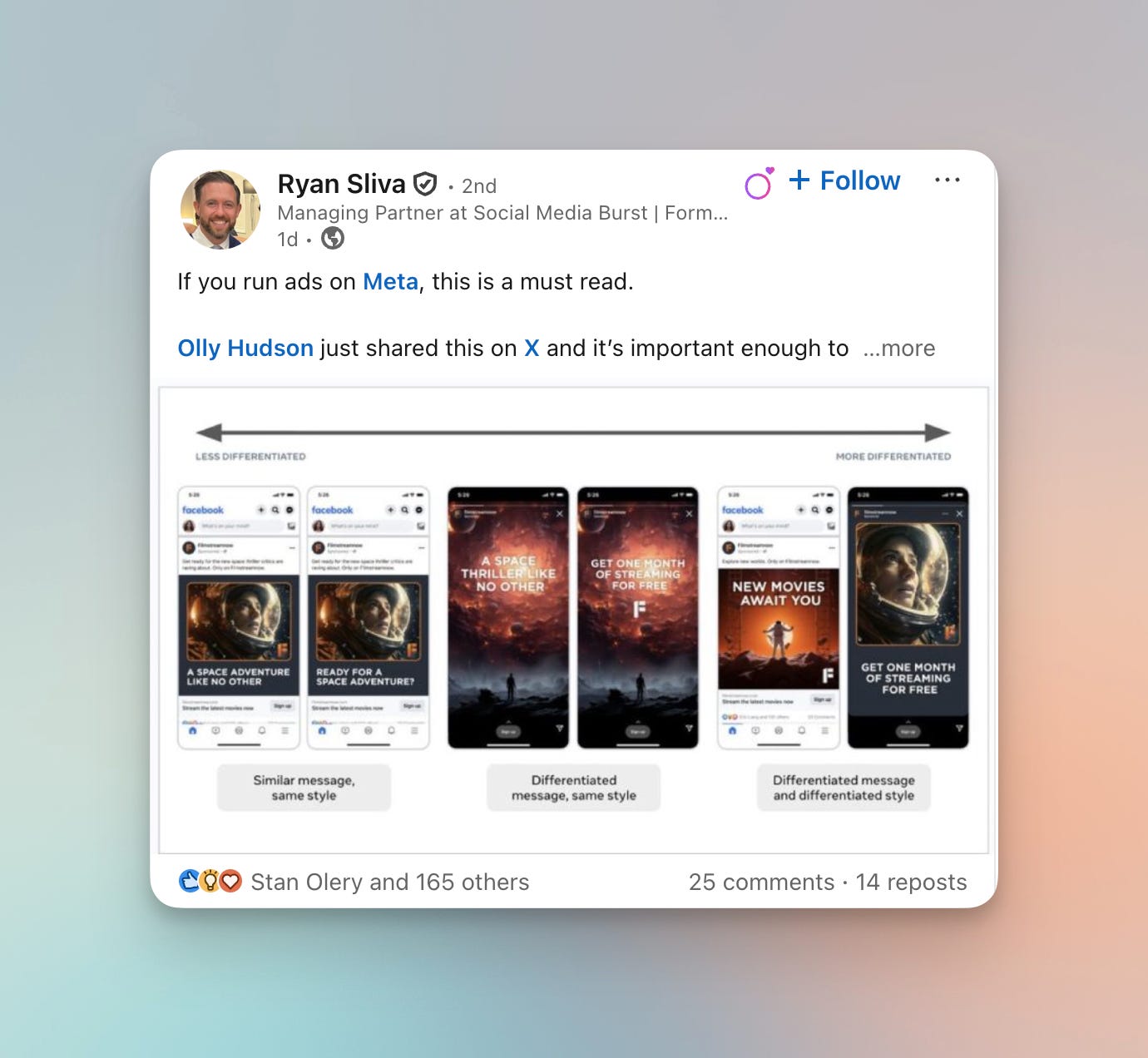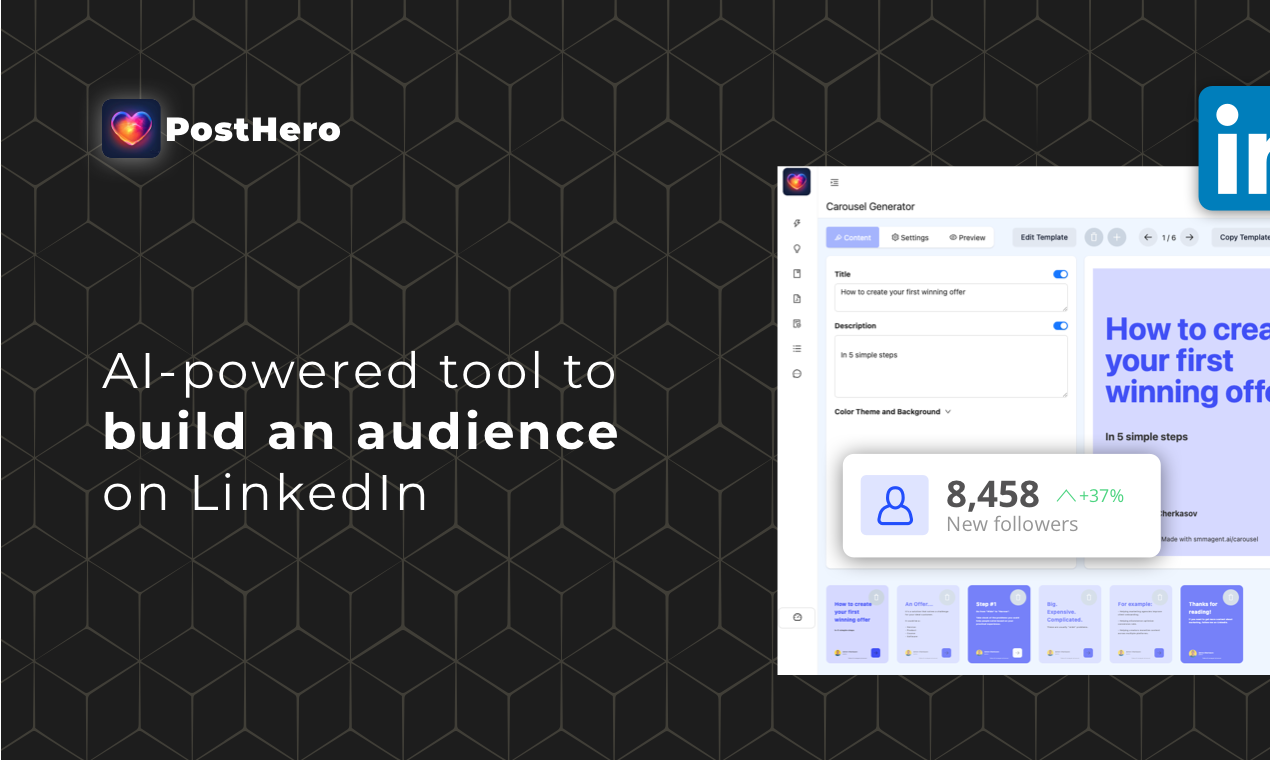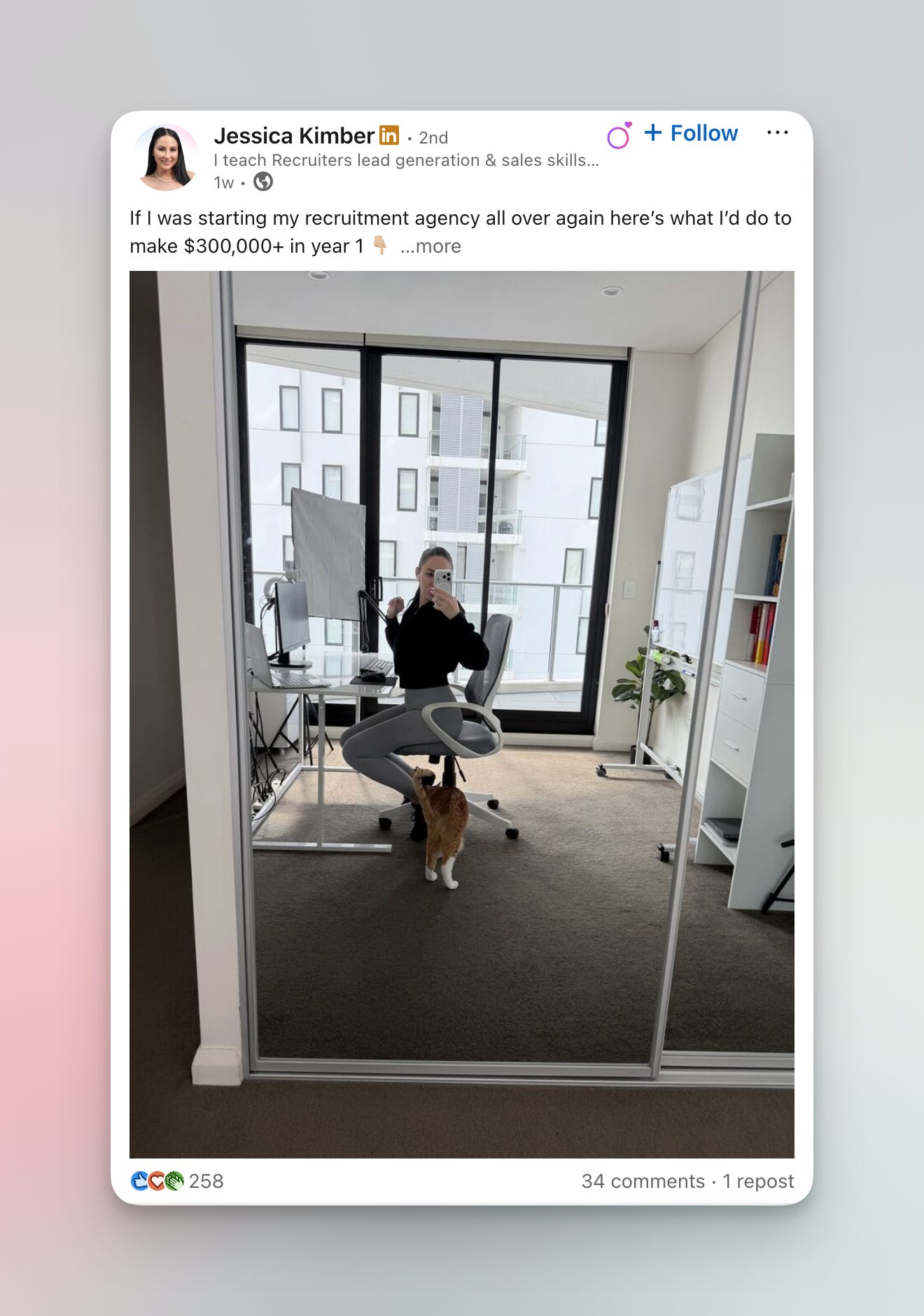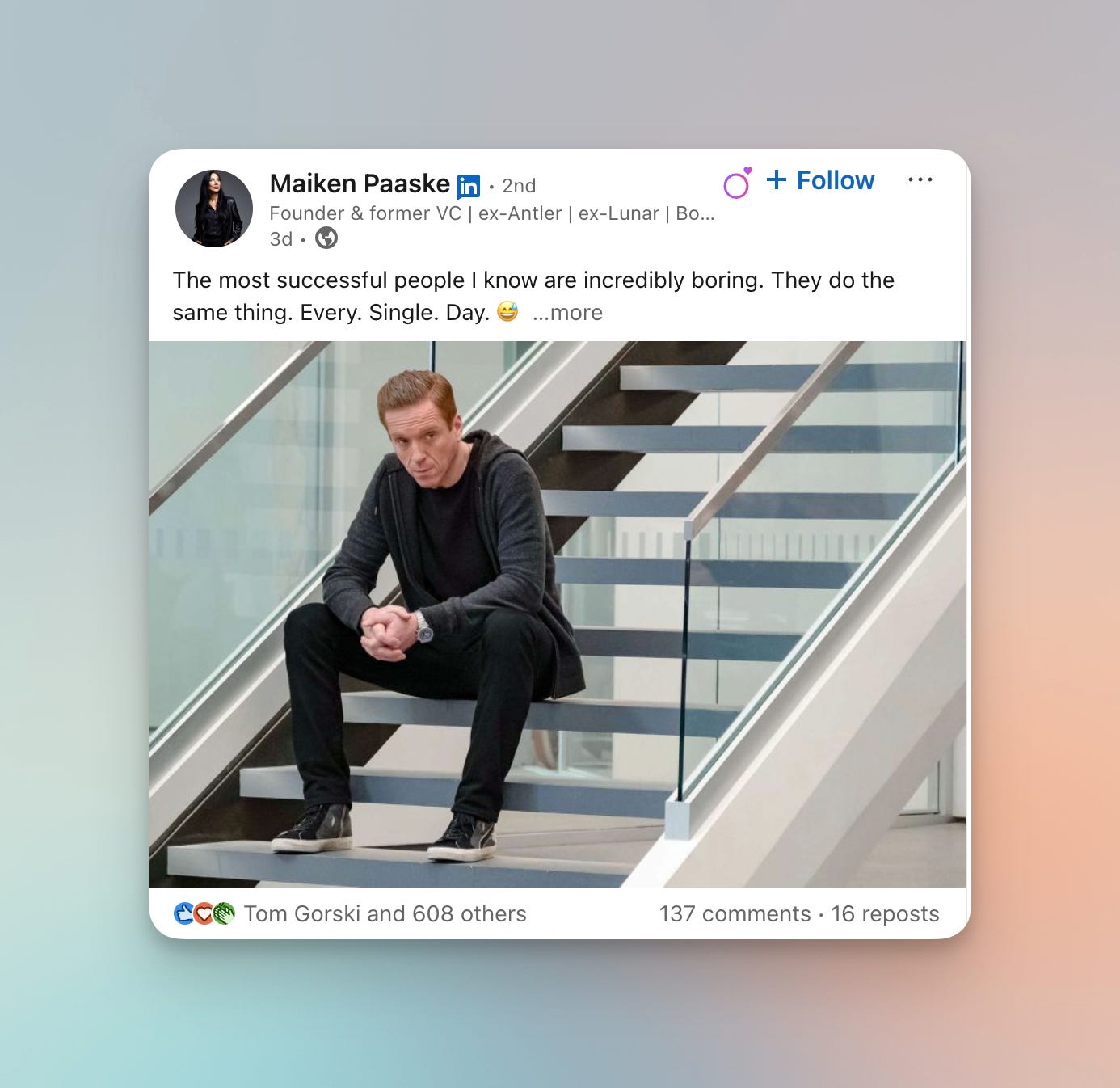LS #62: Why your best LinkedIn content gets fewer likes (but more customers)
Here’s what nobody tells you: The LinkedIn algorithm rewards entertainment. Your business rewards solutions.
Hi there,
I analyze top LinkedIn posts to teach you how to write content that connects.
In this issue, you’ll find:
The 3 high-performing LinkedIn posts this week
Why your best LinkedIn content gets fewer likes (but more customers)
The 3 high-performing posts this week
1. If you run ads on Meta, this is a must read.
Why this post?
This post went viral, receiving almost 165 likes in a day. It received 136 times more engagement and views than Ryan’s posts this month.
WHY THIS POST WENT VIRAL
This post revealed a significant platform algorithm change that directly impacts thousands of advertisers’ performance and budgets. The insider information from a Meta workshop made it feel exclusive and authoritative. Most importantly, it explained both the “what” (algorithm change) and the “why” (Meta wants persona-based variation), giving people the strategic understanding to adapt rather than just following blind tactics.
BREAKDOWN
Urgent attention hook: “If you run ads on Meta, this is a must read” - direct and creates immediate relevance
Social proof credibility: “Olly Hudson just shared this on X” - borrows authority from another expert
Workshop insider access: “key insight from a creative workshop we ran with Meta” - exclusive information
Critical algorithm change: Reveals Meta now treats similar first 3 seconds as “identical” ads
Specific technical details: Breaks down exactly how Meta defines similarity and why it matters
Actionable iteration tactics: Four checkmark strategies with specific implementation details
HOW TO CREATE YOUR OWN POST:
Start with conditional urgency: “If you [do X], this is critical” makes people self-select into reading
Borrow credibility strategically: Credit the original source to show you’re connected to insider info
Signal exclusive information: Mention workshops, beta programs, or direct platform conversations
Explain the technical change: Don’t just say “algorithm changed” - explain exactly how it works now
Provide concrete data: Real percentages from actual performance give your advice credibility
POST IDEAS FOLLOWING THIS TEMPLATE:
“If you’re running Google Ads in 2025, this algorithm change will kill your ROAS”
“TikTok just changed how it counts ‘views’ - your metrics are lying to you”
“LinkedIn quietly updated its feed algorithm - here’s what actually works now”
“YouTube’s new retention metric means your first 30 seconds strategy is obsolete”
“Instagram Reels algorithm changed - vertical content isn’t enough anymore”
TOGETHER WITH POSTHERO
Grow your audience faster on LinkedIn. With an AI-powered tool that helps you create content and grow on LinkedIn.
Create high-converting content that helps you grow on LinkedIn
Create a weekly content in 76 seconds
AI Voice assistant for creating content in seconds
2. If I was starting my recruitment agency all over again here’s what I’d do to make $300,000+ in year 1 👇🏼
Why this post?
Another post that went viral this week—it got 1k likes in a week and performed 7-35 times better than Jessica’s other posts this month.
WHY THIS POST WENT VIRAL
This post gave readers a complete business blueprint from someone who’s already built the thing they want to build. The specific revenue target ($300K year 1) made it feel achievable but still impressive. Jessica’s willingness to name specific tools and give exact strategies (not just vague advice) built massive trust.
BREAKDOWN:
Bold revenue claim: “$300,000+ in year 1“ - specific number grabs attention
Aspirational lifestyle photo: Clean modern office with floor-to-ceiling windows and a cat - shows the dream life
“If I was starting over” framework: Makes it feel like battle-tested wisdom, not theory
Step-by-step process: Breaks down entire strategy into clear, sequential actions
Specific tool recommendations: Names actual tools like SignalHire, JobAdder for credibility
HOW TO CREATE YOUR OWN POST:
Use “if I was starting over” angle: Shows you know the optimal path after learning the hard way
Start with niche clarity: Help people understand picking the right market is 80% of success
Name specific tools: Don’t be vague about “research” - tell people exact software to use
Give activity-based advice: Don’t just say “work hard” - explain exactly what to do daily
Include revenue milestones: Show the progression from $0 to consistent monthly income
3. The most successful people I know are incredibly boring.
Why this post?
This post performed 6 times better than Maiken’s other posts this week.
WHY THIS POST WENT VIRAL
This post destroyed the myth that success comes from genius hacks, special talents, or lucky breaks - and replaced it with something both disappointing and empowering: boring repetition.
BREAKDOWN:
Counterintuitive opening: “The most successful people I know are incredibly boring” - challenges glamorous success narrative
Relatable contrast: “While everyone else is chasing the next hack” - sets up us vs. them dynamic
Simple solution reveal: “they’re doing reps” - strips success down to one unglamorous action
Anti-glamour messaging: “Consistency isn’t sexy. It doesn’t photograph well.” - kills the Instagram fantasy
Talent myth destruction: “They’re not 10x more talented. They’re not lucky.” - removes excuses
HOW TO CREATE YOUR OWN POST:
Challenge popular beliefs: Take something everyone thinks is exciting and show it’s actually boring
Use dramatic punctuation: Periods. Between. Words. creates emphasis and forces people to slow down
Create clear contrasts: Show what unsuccessful people do vs. what successful people actually do
Give specific numbers: Don’t say “many calls” - say exactly “247th customer call”
List the unsexy moments: Detail the specific times when people want to quit but winners don’t
LinkedIn Guide
Why your best LinkedIn content gets fewer likes (but more customers)
My post about AI images got 92k views and 300+ likes.
My post about “How one SaaS founder generated 1,500 LinkedIn leads in 30 days” got 15k views and 131 likes.
Guess which one generated 18 qualified demos and new customers?
Here’s what nobody tells you: The LinkedIn algorithm rewards entertainment. Your business rewards solutions.
The Engagement-Revenue Paradox
What founders chase:
Posts that go “viral”
Hundreds of likes and comments
Followers who engage consistently
Profile views and impressions
What actually drives revenue:
Posts that attract the right 50 people
Comments from qualified prospects
DMs asking “how did you do this?”
Conversations that turn into customers
The harsh truth: Your most viral content is probably your least valuable content.
Why Viral Content Fails You
The Viral Content Formula
What gets maximum engagement:
Motivational quotes and life advice
Controversial hot takes on trending topics
Personal stories with emotional appeal
Lists and frameworks everyone can relate to
Example of viral content: “10 lessons I learned building my startup:”
Why it goes viral:
Broadly relatable (applies to everyone)
Easy to engage with (quick like, move on)
Safe to share (won’t look bad sharing it)
Algorithms love it (high engagement rate)
Who engages:
Other founders scrolling for inspiration
Aspiring entrepreneurs
Content creators looking for ideas
People who will never buy from you
Business results: Zero. None. Nada.
The Customer-Generating Content Formula
What converts to customers:
Specific problem you solved
Technical details and methodology
Results with real numbers
Industry-specific insights
Example of converting content: “How we reduced SaaS onboarding churn from 35% to 12% in 60 days:”
Why it doesn’t go viral:
Too specific (only relevant to SaaS founders with this problem)
Requires deep reading (not scroll-friendly)
Technical details (intimidates casual readers)
Narrow audience appeal
Who engages:
SaaS founders with onboarding problems
VPs dealing with activation challenges
Investors looking at this space
Potential customers evaluating solutions
Business results: demos booked.
The Engagement vs Revenue Matrix
High Engagement, Low Revenue Content
Characteristics:
Broad appeal topics
Emotional storytelling
Universal advice
Trending topics
Examples:
“My biggest failure as a founder”
“Why I quit my 6-figure job”
“10 books that changed my perspective”
“The truth about work-life balance”
Engagement: 500+ likes, 80+ comments
Qualified leads: 0-2
Low Engagement, High Revenue Content
Characteristics:
Niche problem-solving
Technical depth
Specific methodologies
Real results with numbers
Examples:
“How we reduced CAC by 60% without changing our product”
“The database architecture decision that saved us $50K/month”
“Why we switched from [Tool A] to [Tool B] for customer analytics”
“The onboarding sequence that doubled our activation rate”
Engagement: 20-100 likes, 10-20 comments
Qualified leads: 5-10
The 3 Types of LinkedIn Content
Type 1: Vanity Content (High Likes, Zero Business)
Purpose: Algorithm boost, brand awareness
Frequency: 10% of your content
Examples: Personal stories, motivational posts, trending topics
When to use: When you need visibility boost or want to grow followers
Type 2: Authority Content (Medium Likes, Some Business)
Purpose: Establish expertise, build trust
Frequency: 30% of your content
Examples: Industry insights, frameworks, predictions
When to use: Building long-term credibility in your space
Type 3: Conversion Content (Low Likes, High Business)
Purpose: Attract and convert qualified prospects
Frequency: 60% of your content
Examples: Specific problem-solving, case studies, methodologies
When to use: When you need pipeline and revenue, not followers
How to Identify Your Best Converting Content
The Conversion Audit Process
Step 1: Review your last 20 posts For each post, track:
Total likes/comments
DMs received about the topic
Demos or sales conversations generated
Revenue attributed to the post
Step 2: Calculate your Conversion Rate Conversion Rate = (Qualified conversations / Total engagement) × 100
Example:
Post A: 500 likes, 2 qualified conversations = 0.4% conversion
Post B: 80 likes, 6 qualified conversations = 7.5% conversion
Post B is 18x more valuable despite 84% fewer likes.
Step 3: Identify patterns What do your high-converting posts have in common?
Topics they cover
Problems they address
Level of specificity
Industry focus
The Strategic Content Mix
The 60-30-10 Revenue-Focused Strategy
60% Conversion Content (Low likes, high business)
Specific problem-solving posts
Case studies with real numbers
Technical methodologies
Industry-specific insights
30% Authority Content (Medium likes, medium business)
Frameworks and processes
Industry trend analysis
Contrarian opinions
Thought leadership
10% Vanity Content (High likes, low business)
Personal stories
Motivational posts
Broad appeal topics
Why this works:
Prioritizes business outcomes over ego metrics
Maintains some visibility for algorithm
Builds authority while driving conversions
Focuses energy on revenue-generating content
How to Write High-Converting, Low-Engagement Content
The Conversion Content Formula
Element 1: Hyper-Specific Problem Not “customer retention” but “SaaS churn in months 2-3 for B2B companies with annual contracts”
Element 2: Real Numbers Not “improved significantly” but “reduced from 35% to 12% in 60 days”
Element 3: Methodology Teaser Share the what and why, hint at the how “The fix had 3 parts... [list them briefly]... The surprising part was [interesting insight]”
Element 4: Qualification Question End with a question that only your ideal customers would answer “Any B2B SaaS founders seeing this specific churn pattern in months 2-3?”
Example Template
“How we [achieved specific result] in [timeframe]:
The problem: [Specific situation with numbers]
What didn’t work:
[Failed approach 1]
[Failed approach 2]
What worked:
[Solution element 1]
[Solution element 2]
[Solution element 3]
Results:
[Metric 1]: [before] → [after]
[Metric 2]: [before] → [after]
The most interesting part: [Unique insight or counterintuitive finding]
[Specific qualification question for ideal customers]?”
Metrics That Actually Matter
Stop tracking:
Post likes
Total engagement rate
Follower growth
Impressions
Start tracking:
Qualified DMs per post
Demos booked from specific posts
Revenue attributed to content
Conversion rate (qualified leads / engagement)
The Mental Shift You Need to Make
From: “How can I make this post go viral?”
To: “How can I attract the right 50 people?”
From: “This needs to appeal to everyone”
To: “This should only resonate with my ideal customer”
From: “More likes = better content”
To: “More qualified DMs = better content”
From: “I need to grow my following”
To: “I need to build my pipeline”
The Revenue-Focused Content Formula
Hyper-Specific Problems (only your ideal customers relate) + Real Results (numbers build credibility) + Methodology Teasers (show expertise, create curiosity) + Qualification Questions (attract right people) = Content that converts
Stop chasing likes. Start tracking revenue.
That’s a wrap for today.
See you next week! If you want more LinkedIn tips, be sure to follow me on LinkedIn (link).
If you love this episode and want to support us, spread the word about us by sharing The LinkedIn Secrets with colleagues. I really appreciate it!
Thank you for reading!
What’d you think of today’s edition?
Help me to understand what you think about this episode. Just reply with a number (1, 2, or 3) to this email.
1 - Damn good
2 - Meh, do better
3 - You didn’t cook it
Your compadre,
Anton “LinkedIn growth strategies” Cherkasov





